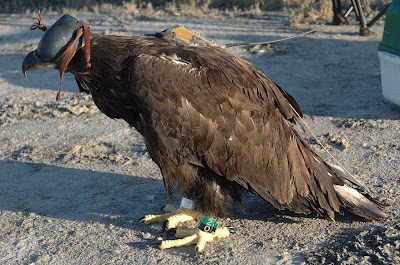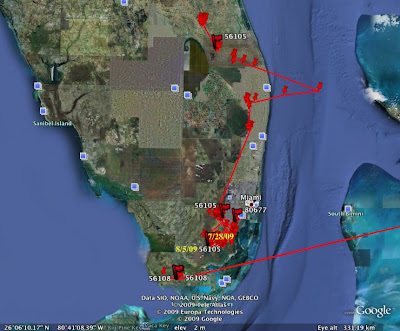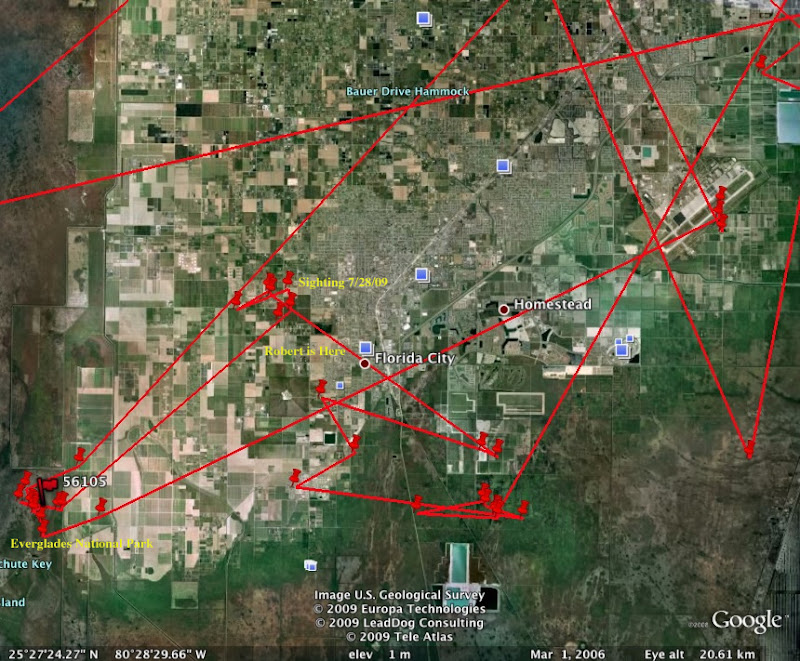(originally posted at
Seetrail) I can't believe I didn't post this when the e-mail came in, but here's a look behind
one Florida Scrub Jay (from Matt's
Scrub-Jays, the Floridians post)
A few details are omitted for privacy, but this is a fascinating look at what goes on in the background! We knew the odds were good that this bird had a story - every jay at
Oscar Scherer State Park is banded, but hey, why not look into it?
Here's the bird in question:

And here's the series of e-mails in chronological order:
USGS-PATUXENT WILDLIFE RESEARCH CENTER
12100 Beech Forest Road
Laurel, Maryland 20708-4037
FAX 301-497-5717
AUGUST 11, 2009
In Reply Refer To: BLL-19.2A
Dear Ms B,
The United States Geological Survey authorizes and coordinates the use of auxiliary-marking devices on all wild, migratory birds. Such devices allow researchers to identify individual or groups of birds from a distance, thus helping them in their studies of various aspects of avian biology.
Enclosed is copy of a letter reporting an auxiliary-marked bird. Our records indicate that you are using markers of this type. Because there is no way from this sighting to identify the individual bird to a specific band number, we will not be able to provide the observer with a certificate. If you believe this to be a bird you marked, it is imperative that you contact the observer with any information you have concerning your studies. If this marker is not yours, please accept our apologies and notify me. If you know of another researcher using similar markers, please indicate the name and/or permit number on the letter.
We have provided a copy of this letter to the observer, who will be anticipating your prompt response.
Sincerely,
D B, Biologist
Bird Banding Laboratory
See ORIGINAL REPORT below:
ORIGINAL REPORTEmail Address: h.trudell [at] gmail [dot] com
Type: color leg band w/o codes
Species: Florida Scrub Jay
Marker Color: white
Other Marker Color:
Code Color: white
Other Code Color:
Pattern of Codes: row
Row:
Top:
Bottom:
Upright:
Sideways:
Other:
Web:
Radio:
How Code: live bird how 29/pres cond 07
How Other:
Recovery Date Type: Exact
Exact Date: 26/07/09
Inexact Date of Recovery:
Recovery Location Descript: Oscar Scherer State Park, the "scrub jay" loop
Recovery Location: USA
Other Country:
State: Florida
County: Sarasota
Miles: 3
Direction: SE
Town: Osprey, FL
Name: H Trudell
Street 1: [street]
Street 2:
City: Waco
State: TX
Zip:
Country:
Phone Number:
Fax Number:
Comment: Right leg was white band over silver/service band, left leg had no bands.
***
From: B, J
Sent: Tuesday, August 11, 2009 12:44 PM
To: M, K
Subject: FW: BLL-192.A: STATE OF FLORIDA - NONGAME / MS B (21980)
These are fun…..do you know this bird?
***
From: M, K
Sent: Tuesday, August 11, 2009 12:46 PM
To: B, J
Subject: RE: BLL-192.A: STATE OF FLORIDA - NONGAME / MS J B (21980)
Probably banded at Oscar Scherer by T H.
-K
__________________
K M, Ph.D.
Upland Nongame Bird Lead
Wildlife Research Laboratory - FWRI
Florida Fish & Wildlife Conservation Commission
***
from H, T
to "H. Trudell"
cc KM, JB, RD
date Wed, Aug 12, 2009 at 11:43 AM
subject RE: Banded Florida scrub-jay
Hello,
We conduct a monthly census of Florida Scrub-jays at Oscar Scherer State Park.
We have not recently had a bird identified with a White over Silver/service, and no bands on the left leg.
However, we do have a bird identified with a Flesh over Silver/service on its right leg, and no bands on its left leg.
This bird was banded at Oscar Scherer State Park on March 24, 1999, and the flesh band has faded.
The bird is currently the male breeder in its territory in the vicinity of the campground.
T H
Environmental Specialist III
District 4, Florida Park Service
Department of Environmental Protection
***
So there you have it - an adult male bird who has been rockin'
OSSP for over 10 years now! I'm glad I didn't just get a certificate, it's so much more fun to hear the details. It didn't take much sleuthing for the bander to let us know that the "flesh" band had faded to white, but that's the sort of thing that regular monitoring tells you. Not bad, for 10 years of sun bleaching in Florida.
What a handsome fellow.







